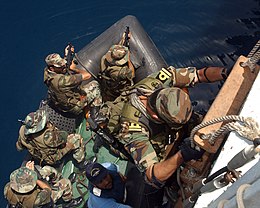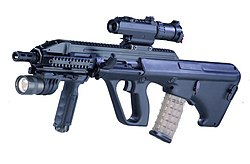Special Service Group (Navy)
| Special Service Group (Navy) | |
|---|---|
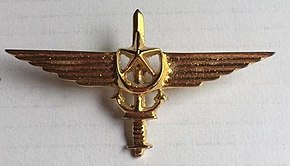 The Special Warfare Insignia/Badge of Pak Navy | |
| Active | 1966—present |
| Country | |
| Branch | |
| Type | Special operations force |
| Role | Special operations (Spec Ops.)
|
| Part of | Naval Strategic Forces Command |
| Garrison/HQ | PNS Iqbal in Karachi in Sindh Nathiagali in Khyber-Pakhtunkhwa[1] |
| Nickname(s) | SEAL Team, Navy SEAL, SSGN, Frogmen, Black Storks,Daredevils |
| Motto(s) | Let it not be said that we did not prove equal to the task.[2] |
| Engagements | show
See list |
| Website | navy special service group |
The Pakistan Navy Special Service Group:100[3][4] abbreviated SSGN or simply Navy seals, is the special operations force tasked with the conducting the small-unit based military operations in all environmental formats of the sea, air, and land by adopting to the tactics of the unconventional warfare. Buisiness Insider Australia ranked them No.1 in the best elite forces.[citation needed] Their training has a dropout rate of 90%.[2][5]
The command and control of the Special Service Group (Navy) falls under the responsibility of the Naval Strategic Forces Command and its personnel are directly recruited into ISI's Covert Action Division (CAD) upon their retirements from their military service.[5]
There is no official report on the actual strength or their military missions since their operational works are subjected to the secrecy by the federal government of Pakistan; knowledge of their works and tactics known in public through the only authorized media works and nonfiction works by the navy veteran.[6]
History[]
[]
After the second war with India in 1965, the Pakistan Navy recognized the need for establishing the armed forces diving unit to conduct the covert reconnaissance of landing beaches and coastal defenses from the attacks by the approaching enemy.[7] Despite its vision and efforts, the Navy had little experience in combat diving and had little educational understanding about the nature of the seaborne special operations.:contents[8] In 1966, Vice-Admiral S. M. Ahsan took personal initiatives establishing the special operations force within the Navy by organizing the underwater demolition teams (UDTs) tasked with gathering intelligence while operating the midget submarines.[9]
The establishment of the Special Service Group (Navy) lies from the contribution by the Pakistan Army's Special Service Group whose frogmen team— the Musa Company— first initially trained the Navy personnel on the military combat diving in 1966.:contents[8] Initially training of the personnel volunteered for the Special Service Group (Navy) took place in Cherat in Khyber Pakhtunkhwa, first initially getting trained for the coastal defenses.:contents[10]
Crucial training on getting trained on the sea, air, and land environmental formats came from the United States Navy when the first unit of the U.S. Navy SEALs was detached to the Pakistan Navy in Karachi, also in 1966.:71 The teams in the Navy Special Service Group were given training on the armed forces diving, high-altitude parachuting, demolitions, foreign languages, and the intelligence management for the intelligence services.[11]
In 1970, the joint training of the Navy SSG and the U.S. Navy SEALs took place in Naval Base Iqbal in Karachi coast, receiving training and getting the expertise in the sea, air, and land environmental formats.:71
Since the 1970s, the Navy SSG teams are occasionally sent to the United States for specialized courses and training conducted with the United States Navy SEALs.[12]
Deployments, covert actions and current history[]

On March 1971, the Navy SSG were deployed in the East-Pakistan to support the Army Special Service Group (SSG) instead of the Army's frogmen team— the Musa Company that remained in Pakistan to conduct the inland waterways operations.:contents[10] Their first direct action based military mission took place in an counterinsurgency operation in Barisal in East-Pakistan, which turned out be a successful in maintaining the control of the city.[13]
On April 1971, the Navy SSG teams were involved in taking another direct actions in Toulon in France when the thirteen East-Pakistani enlists decided to takeover the submarine to try defecting to India but their plans were foiled due to advance knowledge that the Naval Intelligence had gathered on their plans.:43–44[14] The Navy SSG teams engagement with the Bengali insurgents, taking military counter actions at the ports of Chittagong and the Cox's Bazar.[15] The Navy SSG teams operated from Dacca under the command of the Captain Ahmad Zamir but the teams returned to Pakistan in September 1971 to be trained in operating the X-Craft midget submarines.:108[16]
After the third war with India in 1971, the Army–Navy interaction continues with the Navy's taking forefront responsibility of setting the important role in the overall architecture of the special operations forces.:100[3] Over the several years, the Navy SSG teams developed their expertise and considerable long experience in conducting the widespread military special reconnaissance of the India's coastline cities and direct actions in the Indian Ocean.:contents[17] In 1980s, the Navy Special Service Group was deployed in providing military assistance to Sri Lankan military during the civil war in Sri Lanka, playing crucial role to curb the insurgency in the country.:70–73[18]
The Navy SSG's focused moves towards the special military operations to combating terrorism from the seaborne platform after the terrorist attacks in the United States in 2011.[7] The Navy Special Service Group became involved in the Afghan war and the extended military operations in Western Pakistan in a joint coordination with the Army Special Service Group in a conflict with the foreign fighters, Talibans, and the al-Qaeda.:76[19]
The Navy SSG's SEAL Team was involved in taking a crucial direct action against Taliban fighters in dislodging their attack on the Mehran Naval Air Station on May 2011.:76[19]
In 2014, the Navy SEAL Teams successfully engaged the al-Qaeda fighters after they attempted to maneuver the guided missile frigate, the PNS Zulfiquar (251), and successfully neutralize the attack without the damage done to the guided missile frigate as well as apprehending the attackers alive.[20]
Command structure[]
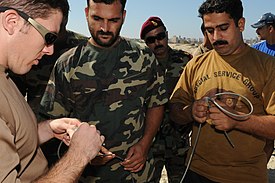
Due to their selective competitiveness, the demanding military physicals, and the commitment required by the Navy's special operations, the Navy Special Service Group is much more tighter contingent compared to the Army Special Service Group, though the selection for the Navy's Special Service Group is open to all naval personnel serving in the different combat branches of the Navy.[5] The Navy SSG is much more discreet than the Army SSG since their operations and works are subjected to the secrecy marked by the Navy though it is known that it is an all-male special operation force.[5]
The control and command structure of the Navy Special Service Group is based in the PNS Iqbal— the naval base in Karachi, Sindh in Pakistan— and their operations are controlled through the Naval Special Operations Training Center (NSOTC).[21] Their armed forces diving training establishment and structure was initially based in the PNS Himalaya but later consolidated their entire structure with the commissioning of the Iqbal Naval Base on 19 March 1967.[22]
The organizational structure of the Navy Special Service Group follows their Army Special Service Group counterparts, and its organizational structure is based on the command formation reporting directly the Commander of the Coastal Areas (COMCOAST).[22] The Navy Special Service Group has three sub command formations that specialized in their own set of war course of actions–each command is specialized in their criterion of war and are considered specialists in their fields.[22]
The Navy Special Service Group's operational responsibility of conducing the special operations, nonetheless, falls under the command of the Naval Strategic Forces Command (ASFC) operating from the Navy NHQ in Islamabad.:44[23]
According to the Navy's official website, the Navy Special Service Group is organized with the Iqbal Naval Base that is having responsible to control the each command.[22]
| Navy SSG Command and Control Headquarters |
| ||||||||||||||||||||||||||||||||||||
(Source: official website)
|
In 1968, the Navy Special Service Group was operating at least six Italian-built SX-404 class midget submarine to function as a SEAL delivery vehicle and had priority over the Hangor program at some time in 1970.:154–155[24] As of 2019, the Navy Special Service Group currently operates at least three Cosmos-class midget submarines that are designed to be inducted for the SEAL Group, and locally known as the "X-Craft.":73[25] The Cosmos-class are currently known to be stationed in PNS Iqbal with the SX-404 class.:154–155[24]
The military administration at the PNS Iqbal also facilitates the advance training of the selected personnel of the Navy special Service Group to be trained with the U.S. Navy SEALs in California and Virginia.[12]
SEALs Teams in the Special Services Group (SSGN)[]
The Navy Special Service Group is composed of the three sub-commands: CO PNS Iqbal, CO SEAL Group, and CO VBSS Group— all are trained in their specialized tasks and considered specialists in the specific type of war operations.[12]
The maritime authors and historians of the Pakistan Navy have provided the rough and the guessed estimation of personnel which was neared around 1,000 SSGN operatives but the department of navy has never issued an actual strength number of its personnel serving in the Navy Special Service Group.:73[19][5]
The official strength and the identities of its personnel serving in each sub-commands are subjected to the secrecy by the department of navy and the Defense ministry has never commented or the Navy itself has never issued the official number of strength of its personnel, including the officers commanding, citing security.[5] In the Navy, the commands of the teams varies by the officer ranking from OF-2 rank (lieutenant) to OF-5 rank (commander), depending on the availability and the difficulty posed by the missions.[5]
| Groups Of Pak Navy Special Services Group (SSGN) | ||
|---|---|---|
| PNS Iqbal Group | Call Name | Details |
| PNS Iqbal Group | CO PNS Iqbal | The Logistical HQ of the Navy SSG. CO Iqbal oversees training, logistics, and support measures for SEAL and VBBS Group. |
| Navy SEAL Group | Call Name | 'Details |
| SEAL Team | SEAL | Oriented towards the Four-dimensionalism—conducts clandestine operations behind the lines without detection on all sea, air, and land formats.[26] |
| Airborne Team | ABT | Oriented towards HAHO/HALO methods in oceans.[7][26] |
| Navy Anti-Terrorist Team | NATT Team | Acted as the quick response team to the seaborne-based terrorist attacks.[22] |
| Underwater Demolition Team | UDT Team | Acted as the specialists on the methods of underwater demolition behind enemy lines.[22] |
| Navy VBSS Group | Call name | Details |
| Visit Board Search Seizure Team | VBSS | Oriented towards the enemy VBSS methods.[22] |
| Close Quarters Battle Team | CQB Team | Oriented towards the hand-to-hand and close-fire range conflict.[22] |
| Naval Interdiction Operation Team | NIO Team | Oriented the interdiction and the maritime security operations.[22] |
Sources: Pakistan Navy official website and GlobalSecurity.org by John Pike.[26]
Selection process and training[]
Qualification and military physicals[]
According to the Pakistan Navy's Medical Corps reports and the media documentaries, the selection is extremely competitive and demands the strong physical conditioning from their prospective candidates prior admitting into the Navy Special Service Group.[6]
The Navy Special Service Group's qualification and military physical standards are akin and reflects the selection criteria of the United States Navy SEALs selection and training, according to Commander Kashif—the senior trainer in the Navy SEAL Team's interview given to Takrar (lit. Confrontation) host Imran R. Khan.[27]
Those prospective candidates who have very high regards of their self respect and their selfless commitment to serve the country only, anytime their services are needed by the Navy for the area deployment, are the only intakes in the Navy Special Service Group, commented by V-Adm. (retd.) —the retired SEAL Team member and the former commander of the Navy SSG.[7]
Drop out attrition rates from the physical standards of the Navy is average between the 80-to-90%, matching the Army Special Service Group's drop rate in Cherat[6] Those who have failed the mental and physical requirements are then sent to their regular jobs in the Navy.[6] The military physical standards, examinations, and criteria is same for the Army, Navy, Air Force, and Marines' special forces selections and training, often training in close coordination.[28] There are three special operations schools in the Pakistan, the Navy's sniper and frogmen school criteria follows the military physical requirement:
- Naval Special Operations Training Center (Naval SOTC)
- Must meet army qualifications with swimming standards.[1]
- Sniper School
- Frogman School
- Swimming Standards
Selection and training[]
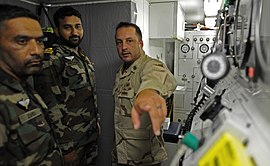
The military physicals for the getting accepted in the Navy is maintained to be very high standard and requires the prospective individual has to spent nearly five years in the Navy that validates their commitment to their profession and the Navy— this is the same requirement for the Army Special Service Group.[28] Training for the Navy Special Service Group is extremely rigorous that included being able to earn the swimming badge after completing the 15 kilometres (9.3 mi) in 10 hours in an open sea,[27] the HALO/HAHO airborne qualification badge,[27] and special weapons qualification badge.[27]
The Navy Special Service Group's training courses :
Training of the Navy Special Service Group also included the training on the Judo/Karateka, Frogman maneuver, and the drownproofing (ability to stay afloat while tide up in the water).[6] The Navy maintains its own Parachute Training School in Oramar based on the Army's Parachute Training School in Cherat, where the prospective individual excelled on its HALO/HAHO and static line skills after performing the combat jump from 15,000 feet (4,600 m)– this course usually held for 4-weeks.[27]
The training courses on the Navy Special Service Group emphasis on the strong mental and physical conditioning that includes the 36-36 miles (58 km) march, a requirement that was first institutionalized by the Army Special Service Group in 1956.[27]
Once the 8-month course is complete, the navy sailors who are volunteering to join the SSGN are then given specialized training in maritime and amphibious warfare at the specialized training school located in Karachi.[27]
The Combat Diver badge is awarded for the course held by the Navy Special Service Group— there are three classes of combat swimmers are recognized: 1st class to complete an 18-mile or more swim in the designated time period; 2nd class to those finishing a 12-mile swim; and 3rd class for a 6-mile swim.[27] Navy's sniper training and air assault courses are held at the Naval Special Operations Training Center (Naval SOTC) in Nathiagali in Khyber-Pakhtunkhwa.[1]
The Navy has its own airborne school in Oramara, frogmen school in Karachi, and the special operations school in Nathiagali.[1][30] The advance training on the special warfare environments jointly takes place with the Army Special Service Group where the SEAL Teams are trained in long distance marksmanship sniper warfare at the Army Sniper School, arctic warfare at the Army School of High Altitude, mountain warfare at the Army School of Mountain Warfare in Cherat, desert warfare in Chor, and often popular in the country for taking participation with the army's snipers in various competition.[31]
Notable members[]
| Name and Members | Portrait | Notes Rank | Notes on Credentials |
|---|---|---|---|
| Fasih Bokhari | — | Admiral | The Chairman of NAB (2011–13), and the Chief of NavalStaff (1997–1999). |
| Abdul Aziz Mirza | — | Admiral | The Chief of Naval Staff (1999–02). |
| S.T.H Naqvi | Vice-Admiral | Commander of Navy Special Service Group, and former Chair of the National Shipping Corporation (2002–05) | |
| Javed Iqbal | — | Vice-Admiral | Diplomat, analyst, and the naval intelligence officer |
| Shamoon Allam | — | Vice-Admiral | Diplomat |
| Maqsood Ahmed | Lieutenant | The retired Navy SEAL, and currently heading the taskforce —Special Security Unit in Karachi |
Influence on foreign units[]
Since its establishment in 1966, the Navy Special Service Group has been influential in the Indian Ocean region and has provided military training to the Special Boat Squadron of the Sri Lankan Navy, SAS of the Turkish Naval Forces, and helped train several special operation units on underwater works to the countries such as Saudi Arabia, Egypt, Qatar, and Bahrain.[22]
Appearance and equipment[]

The Special Forces in Pakistani military adopted their Battle Dress Uniform in favor of the U.S. woodland (or M81) with a maroon berets in 1990.:100[3] The Special Forces in Pakistan follows the combat gear of the Pakistan Army as the Army Special Service Group authorized the U.S. woodland (M81) as their battle dress uniform with a maroon berets, a common color for the airborne forces, with a silver metal tab on a light blue felt square with a dagger and lightning bolts, and a wing on the right side of the chest.:100[3]
The Navy Special Service Group closely follows the Army Special Service Group, adopting to wear the U.S. woodland (or M81) with a maroon berets, a common color for the airborne forces.:71[18]
The Navy Special Service Group is only distinguished by their officially issued berets— a dark blue beret with three versions of the "fouled anchor" badge for the all of its personnel.:71[18] A metal SSGN qualification badge featuring a vertical dagger superimposed over a midget submarine is worn over the left pocket on dress uniforms. Parachute wings are worn over the right pocket.:71[18]
Weaponry[]
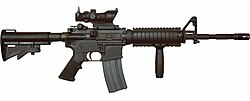

Pistols
 Austria Glock pistol
Austria Glock pistol
Sub-machine guns
 Germany Heckler & Koch MP5
Germany Heckler & Koch MP5 Belgium FN P90
Belgium FN P90
Assault rifles
Sniper rifles
 Pakistan POF PSR-90M
Pakistan POF PSR-90M USA Barrett M82
USA Barrett M82
Light Machine guns
 Belgium FN Minimi
Belgium FN Minimi
Air Defence & Rocket Launchers
 Soviet Union RPG7
Soviet Union RPG7 USA SMAW
USA SMAW Pakistan Anza MANPADS
Pakistan Anza MANPADS
Helmets
 Pakistan POF Standard Helmet
Pakistan POF Standard Helmet USA Light Weight Helmet
USA Light Weight Helmet
Bullet Proof Jacket/Armor
 Pakistan POF Standard Body Armor
Pakistan POF Standard Body Armor
See also[]
- 1st Marines Battalion (Pakistan)
- Special Service Group (Pakistan Army)
- Special Service Wing (Pakistan Air Force)
- List of military special forces units
References[]
- ^ Jump up to: a b c d "Counterterrorism training provided by the Pakistan Navy to be an Asset to effectively challenge the terrorists". www.pressreader.com. Press readers. 26 August 2017. Retrieved 17 February 2019.
- ^ Jump up to: a b Baloch, Qaim Ali. "Commandos from Beyond the Silence of the Sea" (.watch). www.youtube.com. Retrieved 10 February 2019.
- ^ Jump up to: a b c d Oberoi, Vijay (2006). Special Forces: Doctrine, Structures, and Employment Across Spectrum of Conflict in the Indian Context. Knowledge World. p. 458. ISBN 9788187966395. Retrieved 11 February 2019.
- ^ The Special Services Group Navy was established by the United States Navy SEALs in 1966. The SSG(N) or SSG-N is known by other names. There are also known as "Pakistan Naval SEALs", "Naval Special Services Group", "Naval Commandos (Pakistan Navy)"
- ^ Jump up to: a b c d e Khan, Wajahat Saeed. "Mahaaz with Wajahat Saeed Khan - Pak Navy Ka Mahaaz - 29 October 2017 - Dunya News". Dunya News. Retrieved 10 February 2019.
- ^ Jump up to: a b Ryan, Mike; Mann, Chris; Stilwell, Alexander (2014). "(§Special Forces: Pakistan)". The Encyclopedia of the World's Special Forces: Tactics, History, Strategy, Weapons (google books). Amber Books Ltd. ISBN 9781907446894. Retrieved 30 January 2019.
- ^ Goldrick, James (1997). No Easy Answers. New Delhi: Lancer's Publications and Distributors. ISBN 1-897829-02-7.
- ^ Jump up to: a b Conboy, Kenneth (2012). "(§Naval Special Forces)". In Hannon, Paul (ed.). Elite forces of India and Pakistan (google books) (1st ed.). Indiana, U.S.: Bloomsbury Publishing. p. 64. ISBN 9781780967677. Retrieved 10 February 2019.
- ^ Jump up to: a b c Pakistan Navy Special Forces Archived 2011-06-29 at the Wayback Machine Global Special Forces
- ^ Usman, Shabbir (1 June 2003). "Riverine Operations of PN Gunboats in East Pakistan « PakDef Military Consortium". www.pakdef.org. Karachi. Pakistan: PakDef Military Consortium. Retrieved 11 February 2019.
- ^ Jacob, Lt. Gen. J. F. R., Surrender at Dacca, Birth of A Nation, pp. 43-44
- ^ Surrender at Dacca: Birth of A Nation, Jacob, Lt. Gen. J. F. R., p. 90
- ^ Hiranandani, G. M. (2000). "(§Pakistan Navy's Underwater Forces Program)". Transition to Triumph: History of the Indian Navy, 1965-1975 (google books). New Delhi, India: Lancer Publishers. p. 400. ISBN 9781897829721. Retrieved 11 February 2019.
- ^ Ryan, Mike; Mann, Chris; Stilwell, Alexander (2014). The Encyclopedia of the World's Special Forces: Tactics, History, Strategy, Weapons. Amber Books Ltd. ISBN 9781907446894. Retrieved 11 February 2019.
- ^ Jump up to: a b c d USA, IBP (2009). Pakistan Intelligence, Security Activities and Operations Handbook. Lulu.com. ISBN 9781438737218.
- ^ Jump up to: a b c Waters, Conrad (2011). Seaforth World Naval Review 2012. New York, U.S.: Seaforth Publishing. p. 200. ISBN 9781783466320. Retrieved 11 February 2019.
- ^ Zaman, Fahim; Ali, Naziha Syed (13 September 2014). "Dockyard attackers planned to hijack Navy frigate". DAWN.COM. Karachi, Sindh, Pakistan: Dawn Newspaper. Dawn Newspaper. Retrieved 20 December 2018.
- ^ "50 glorious years of Pakistan Navy's SSG". News International. 29 March 2017. Retrieved 12 February 2019.
- ^ Jump up to: a b c d e f g h i j k l m "PNS Iqbal". www.paknavy.gov.pk. Retrieved 12 February 2019.
- ^ Mukherjee, Anit; Mohan, C. Raja (2015). India's Naval Strategy and Asian Security. Routledge. p. 260. ISBN 9781317361343. Retrieved 12 February 2019.
- ^ Jump up to: a b Singh, Kunwar Rajendra; Analyses, Institute for Defence Studies and (2002). Navies of South Asia. Rupa & Co. published under the auspices of Institute for Defence Studies and Analyses. p. 459. Retrieved 12 February 2019.
- ^ Waters, Conrad (2011). Seaforth World Naval Review 2012. USA: Seaforth Publishing. p. 191. ISBN 9781783466320. Retrieved 12 February 2019.
- ^ Jump up to: a b c d e f g h Khan, Imran R. (6 September 2016). "Express News: Defense Day Special: The Pakistan SSG Navy" (.watch/tv). www.youtube.com (in Urdu). Karach/Gwadar coast: Express News. Retrieved 13 February 2019.
- ^ Jump up to: a b c d e f g "Special Operations School: Selection Criteria". www.pakistanarmy.gov.pk. Retrieved 26 January 2019.
- ^ Khiyal, Cdr. Roshan (21 February 2011). "History of the Special Service Group (SSG) - Pakistan Army - Part 1" (.watch). /www.youtube.com (in Urdu). Islamabad: ISPR YouTube. Retrieved 26 January 2019.
- ^ "Special Service Group (Pakistan Navy)". www.facebook.com. Retrieved 17 February 2019.
- ^ Newspaper, the (3 November 2015). "Raheel praises army shooters' marksmanship". DAWN.COM. Retrieved 17 February 2019.
External links[]
Further reading[]
- Ryan, Mike; Mann, Chris; Stilwell, Alexander (2014). The Encyclopedia of the World's Special Forces: Tactics, History, Strategy, Weapons. Amber Books Ltd. ISBN 9781907446894. Retrieved 14 February 2019.
- Shah, Rear-Admiral Mian Zahir (2001). Bubbles of water, or, Anecdotes of the Pakistan Navy (1st ed.). Karachi: PN Book Club Publication. p. 487. ISBN 9698318038. Retrieved 14 February 2019.
Official media site[]
- "Special Service Group (Pakistan Navy)". www.facebook.com. Retrieved 17 February 2019.
Media files[]
- Khan, Wajahat Saeed (12 April 2011). "VBSS Team Training by W.S. Khan— Dawn News Documentary" (watch.tv). www.youtube.com. Karachi, Sindh, Pakistan: Navy ISPR. Retrieved 10 February 2019.
- Khan, Imran R. (6 September 2016). "Navy SEAL Team training by I.R. Khan— Express News Documentary" (.watch.tv). www.youtube.com (in Urdu). Karach/Gwadar coast: Express News. Retrieved 13 February 2019.
- Pakistan Navy
- Armed forces diving
- Special forces of Pakistan
- Naval special forces units
- Military units and formations established in 1966
